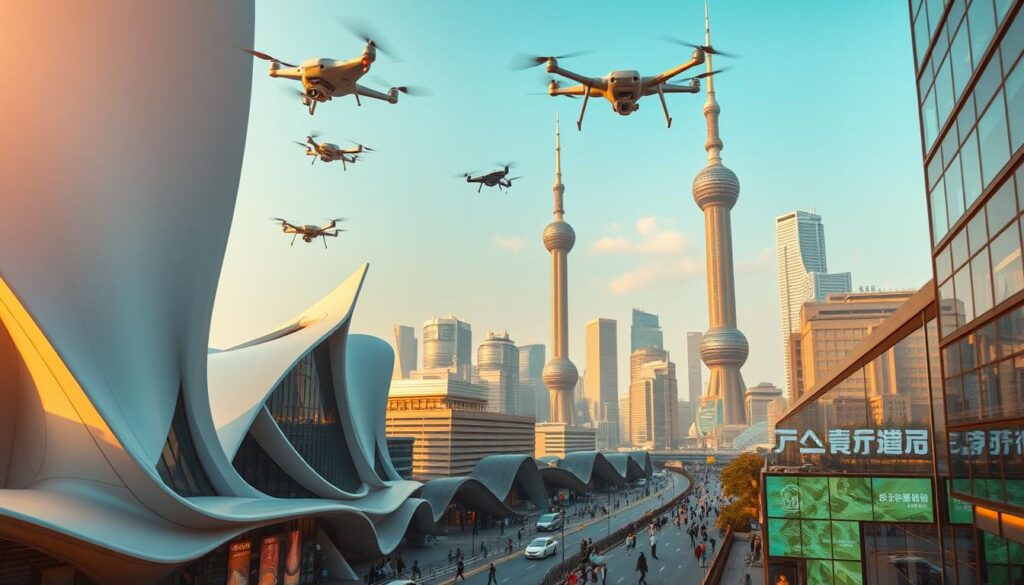As Bill Gates once said, “The advance of technology is based on making it fit in so that you don’t really even notice it, so it’s part of everyday life.” This sentiment perfectly captures the rapid evolution of artificial intelligence in China, a nation that has become a global powerhouse in this transformative technology.
China’s artificial intelligence sector has seen remarkable growth, with a staggering 67% increase last year alone. This surge is fueled by significant investments and strong government support, positioning the country as a leader in the global AI landscape. Nearly two-thirds of global AI funds are now directed toward Chinese companies, highlighting the sector’s immense potential1.
From startups to established giants, Chinese firms are driving innovation in artificial intelligence. Companies like DJI, Ubtech, SenseTime, Cambricon, and Cloudwalk are at the forefront, shaping the future of this industry. Their contributions are not only transforming China but also influencing the world.
This article delves into the key players making waves in China’s artificial intelligence scene. We’ll explore their innovations, the role of government backing, and how they are setting new benchmarks in technology. Stay tuned to discover how these companies are redefining the future of AI.
Key Takeaways
- China’s artificial intelligence sector grew by 67% last year1.
- Nearly two-thirds of global AI funds are invested in China1.
- Startups and established companies are driving innovation in AI.
- Government support plays a crucial role in the sector’s growth.
- Top companies like DJI and SenseTime are shaping the industry.
China’s Evolving Artificial Intelligence Landscape

The journey of artificial intelligence in China began in the late 1970s, marking a pivotal shift in technological innovation. During this period, economic reforms under Deng Xiaoping laid the groundwork for advancements in the field. Early research efforts were often hindered by limited resources, but Chinese scholars who studied abroad brought back valuable knowledge, fueling domestic progress2.
By the 1980s, the government started to recognize the potential of AI, integrating it into national agendas. Policies like the “Made in China 2025” plan further emphasized the importance of tech innovation. These initiatives provided the necessary funding and framework for breakthroughs in the intelligence sector3.
Historical Growth and Early Developments
In the early years, Chinese researchers faced significant challenges, including limited access to global datum and high costs. However, the government’s commitment to research and development helped overcome these obstacles. By the 1990s, China began to establish itself as a serious contender in the AI field.
Key milestones, such as the launch of national AI labs and the establishment of academic programs, accelerated progress. These efforts laid the foundation for a mature, research-driven ecosystem that continues to thrive today4.
Global Investment and Market Expansion
China’s AI sector has attracted significant global investment, with major tech giants like Alibaba and Tencent leading the charge. The cost of developing AI models has dropped dramatically, making it easier for companies to innovate. For example, the cost of inferencing for AI models in China has fallen by over 95% in the past year3.
Government support has also played a crucial role. Policies like the “Made in China 2025” plan have encouraged both domestic and international investments. This has helped China become a global leader in AI, with its companies releasing advanced models that are freely available for modification2.
Today, China’s AI landscape is a testament to decades of strategic focus and innovation. From early challenges to a thriving ecosystem, the country’s journey in artificial intelligence continues to shape the global state of technology.
5 Key Players in China’s AI Industry

China’s artificial intelligence sector is home to some of the most innovative companies shaping the future of technology. These firms are not only leading in their respective fields but also driving global advancements in robotics, facial recognition, and chip development.
DJI: Leader in Drone and Robotics Innovation
DJI has revolutionized the drone industry, holding a 70% global market share. The company has expanded its expertise from consumer drones to enterprise robotics, integrating advanced image recognition models. This shift has positioned DJI as a key player in both consumer and industrial applications5.
Ubtech: Transitioning to Enterprise Robotics
Ubtech has evolved from creating consumer robots to developing technologies for local governments and schools. Their robots are now used in educational settings and public services, showcasing their capability to adapt and innovate in diverse markets6.
SenseTime: Pioneering Facial Recognition Technology
SenseTime is a leader in facial recognition, supporting public security initiatives with its advanced models. The company’s technology is integrated into over 170 million CCTV cameras, making it a critical agent in enhancing public safety5.
Cambricon: Advancing AI Chip Capabilities
Cambricon is making waves in the AI chip market, collaborating with giants like Huawei. Their chips are designed for high-performance smart devices, offering significant improvements in processing power and efficiency7.
Cloudwalk: Expanding Public-Security Solutions
Cloudwalk has expanded its public-security solutions, venturing into international markets like Zimbabwe. Their open-source models and advanced intelligence algorithms are setting new standards in security technology6.
These companies exemplify the innovation and expertise driving China’s artificial intelligence sector. Their contributions are not only transforming local industries but also influencing global technology trends. For more insights into how artificial intelligence is revolutionizing industries, explore AI tools.
Technological Innovations Empowering AI Advancements

Technological breakthroughs are reshaping the artificial intelligence landscape, driving unprecedented advancements. From machine learning to computer vision, these innovations are not only enhancing product performance but also redefining the capability of AI systems. This section explores the cutting-edge tech that is powering the next generation of artificial intelligence.
Machine Learning and Natural Language Processing Breakthroughs
Machine learning techniques have evolved significantly, enabling AI models to process vast amounts of data with remarkable accuracy. For instance, Lenovo’s AI algorithm reduced production scheduling time from six hours to just 1.5 minutes, showcasing the performance improvements driven by advanced software8.
Natural language processing (NLP) has also seen major strides, enhancing human-computer interactions. Innovations in NLP are now being integrated into various tools, making them more intuitive and user-friendly. These advancements are not only improving product quality but also setting new standards in the industry9.
Integration of Computer Vision in Drones and Robotics
Computer vision is another area where tech innovations are making a significant impact. DJI, for example, has integrated advanced image recognition models into its drones, enabling smarter and safer applications. This innovation has transformed both consumer and industrial uses of drone technology8.
In robotics, computer vision is enhancing capability by enabling machines to interpret visual data more effectively. This has led to safer and more efficient operations in industries ranging from manufacturing to public security. For more insights into how AI is revolutionizing industries, explore AI tools.
Government Influence and Strategic Investments in AI

The Chinese government has played a pivotal role in shaping the artificial intelligence landscape through strategic investments and policy frameworks. With a vision to make AI a cornerstone of its economic future, the government has set ambitious goals, including an AI market worth 1 trillion yuan by 203010.
National Policy Framework and Funding Initiatives
China’s commitment to AI is evident in its robust policy framework. The “Made in China 2025” plan and the “Next Generation Artificial Intelligence Development Plan” have provided a clear roadmap for growth. These initiatives have spurred significant funding, with government venture capital funds investing $912 billion over the past decade11.
These funds have been strategically allocated, with 23% directed towards 1.4 million AI-related firms. This has enabled rapid advancements, particularly in software production, which saw a 500% growth by 202311.
Public-Private Research Collaborations
Collaborations between the government and private enterprises have been instrumental in driving innovation. For instance, 4,115 AI firms received investments from both government and private venture capital funds between 2000 and 202311. This synergy has accelerated the development of cutting-edge technologies.
One notable example is the Shanghai City Xuhui Government Services Large Model, launched in June 2024. This initiative focuses on improving government service efficiency through AI, showcasing the potential of public-private partnerships10.
Such collaborations not only enhance technological capabilities but also influence enterprise strategies, fostering a culture of innovation. For more insights into how AI is transforming industries, explore China’s AI industry.
Market Trends and Competitive Dynamics in the AI Sector
The artificial intelligence sector is witnessing rapid shifts in market dynamics, driven by global competition and strategic investments. With the global AI market projected to grow from $184.15 billion in 2024 to $2.53 trillion by 2033, the stakes are higher than ever12. China, a dominant player, has attracted $85.65 billion in investments, reflecting strong market confidence13.
Investment Milestones and Valuation Growth
Recent years have seen significant investment milestones in the AI sector. Chinese government venture capital funds have invested $184 billion in AI-related firms since 2000, supporting over 9,623 unique companies13. This influx of capital has fueled innovation and growth, with generative AI products leading the charge. As of March 2024, at least 117 generative AI products have been approved in China, showcasing the sector’s rapid evolution13.
Valuation growth is another key indicator of market strength. Companies like Baichuan and SenseTime have achieved impressive performance scores on benchmarks like SuperCLUE, reflecting their technological advancements13. These achievements highlight the growing competitiveness of Chinese firms in the global arena.
International Competition and Strategic Direction
International competition is shaping the strategic direction of the AI sector. While the United States leads with 9,500 AI companies and $605.42 billion in investments, China’s 1,944 firms are making significant strides13. The competition is not just about numbers but also about innovation and market share.
For instance, Alibaba’s Qwen 1.5 model, with 72 billion parameters, competes directly with OpenAI’s GPT-4 Turbo, which scored 79 on the SuperCLUE benchmark13. This rivalry is driving advancements in natural language processing and other AI technologies, benefiting users worldwide.
Strategic collaborations and government support are also crucial. The “New Generation Artificial Intelligence Development Plan” in China has spurred investments and research, positioning the country as a global leader12. For more insights into China’s AI transformation, explore the Blueprint to Action report.
In summary, the AI sector is evolving rapidly, with investment milestones, valuation growth, and international competition driving its trajectory. As the world watches, China’s strategic direction and innovations continue to shape the future of artificial intelligence.
Challenges and Opportunities for Chinese AI Enterprises
Chinese enterprises in the artificial intelligence sector are navigating a complex landscape of challenges and opportunities. While rapid advancements in intelligence and research have positioned China as a global leader, issues like data privacy, ethical concerns, and regulatory hurdles remain significant obstacles.
Data Privacy, Ethics, and Regulatory Hurdles
Data privacy is a critical concern for Chinese AI companies. With millions of surveillance cameras installed across the country, the use of AI in public monitoring has raised ethical questions14. Regulatory frameworks, such as those enforced by the Cyberspace Administration of China (CAC), require companies to comply with stringent policies on sensitive topics15.
These regulations, while necessary, can increase the cost of innovation. For example, the DeepSeek-R1 model faced bans in multiple countries due to data privacy concerns16. Balancing compliance with the race to innovate is a constant challenge for enterprises in this field.
Balancing Innovation with Economic Strategy
Chinese AI companies are also tasked with aligning technological advancements with national economic strategies. The government’s focus on AI as a cornerstone of economic growth has led to significant investments, with $1.4 trillion planned by 203016. However, this support comes with expectations for companies to contribute to broader economic goals.
Ongoing research and development efforts are dedicated to improving algorithm efficiency and intelligence. For instance, Baidu’s ERNIE Bot has been adopted by over 26,000 enterprises, showcasing the potential of AI to drive productivity15.
Fierce competition and the race to innovate influence enterprise strategies. Companies must push technological frontiers while adhering to economic and regulatory frameworks. For more insights into how AI is transforming industries, explore AI tools.
Conclusion
China’s advancements in artificial intelligence have positioned it as a global leader in technology. With significant investments from the Chinese government, the sector has seen remarkable growth, aiming for a $1 trillion market by 203017. Companies like Baidu and SenseTime are driving innovation, with Baidu holding a 19.9% market share in the LLM sector17.
Strategic plans and focus on open-source initiatives have further accelerated progress. Over 100 LLMs emerged in China within a single year, showcasing the country’s rapid development18. However, challenges like the shortage of advanced chips remain, impacting the cost and performance of AI models18.
Looking ahead, balancing innovation with economic strategy will be crucial. As global competition intensifies, China’s ability to adapt and lead in artificial intelligence will shape the future of technology worldwide. For more insights, explore ChatGPT’s role in AI.
FAQ
What are the key areas of focus for China’s AI industry?
How has the Chinese government supported AI development?
What role does machine learning play in China’s AI advancements?
What challenges do Chinese AI companies face?
How does China’s AI industry compete globally?
What are the major trends in China’s AI market?
How do Chinese AI companies integrate computer vision?
What is the significance of AI chips in China’s tech landscape?
Source Links
- Hurun Report – Info – 2024 Hurun China Artificial Intelligence Enterprises Top 50
- China banks on open source in AI cold war with US
- China’s AI development could speed up AI adoption
- DeepSeek: The ChatGPT Moment For China’s Internet Companies – KraneShares
- Meet 5 of the Chinese AI models upending the market
- Top Companies, Innovations & ChatGPT Rivals
- The Rising AI Stars from China
- China’s manufacturing sector revs up with AI-empowered innovation
- Focus on tech innovations to elevate China’s advancement
- China And AI In 2025: What Global Executives Must Know To Stay Ahead
- Government Venture Capital and AI Development in China
- Growth Trends and Developments in the Artificial Intelligence (AI) Industry, 2025-2033 – Featuring Microsoft, IBM, Amazon, Baidu, Nvidia, Oracle, HPE, Intel, Salesforce, and Alphabet
- How Innovative Is China in AI?
- Challenges and Opportunities of AI in China
- China’s Generative AI Ecosystem in 2024: Rising Investment and Expectations
- China in the Global AI Race: Strengths, Challenges, and the Road Ahead
- Artificial intelligence industry in China
- In Developing AI, China Takes the Industrial Route






